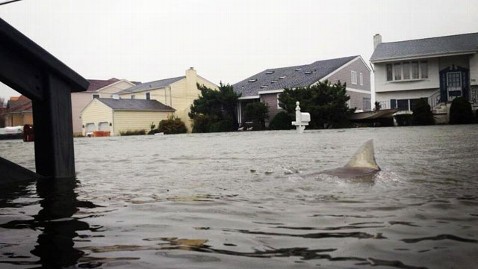Sharks in Floodwaters? Fake Hurricane Sandy Pics, but Still Possible

Image credit: Gregory Michael / Facebook
Amid all the pictures of the floodwaters following Hurricane Sandy, something odd in the deep water keeps popping up on Twitter and Facebook - fins. Shark fins.
While it's generally assumed the fins are fake, they've still caused a fright.
"HOLY CRAP" @stephanieelliot tweeted in response to this shark photo, which was tweeted more than a thousand times. "Please tell me this isn't true," another person posted on Facebook in response to the same photo. Then there was Sean Kingston, who tweeted: "Heard somebody seen a shark just swimming in their neighborhood … because of #Hurricanesandy. This is crazy. Stay safe people!"
The photo shown above and the one in that tweet have been confirmed as fakes - the one above even made the rounds during Hurricane Irene. But these photos raise the inevitable question: Is it possible for sharks to swim up on the shore when floodwaters take over neighborhoods and streets?
"This would certainly be unusual, although not beyond the realm of possibility," Christopher Dold, vice president of veterinary services at SeaWorld, told ABC News. "SeaWorld's wildlife rescue team often helps marine animals in strange predicaments because of tidal changes and unusual water surges. Since Brigantine, like the rest of the New Jersey coast, was inundated with saltwater, in theory a shark could survive in such a scenario. Some sharks, like bull sharks, can even be found in freshwater, and there have been reports of bull sharks hundreds of miles upriver from the ocean."
Dold wasn't the only expert who mentioned bull sharks. A representative at the Dallas Zoo mentioned that bull sharks were notorious for swimming upstream in freshwater. It was bull and white sharks that killed four people on the New Jersey Shore in 1916.
But other experts were more skeptical, and called it fantasy.
"It is highly unlikely. While scientific evidence is scanty, there is one study that demonstrates offshore movement of sharks in advance of an incoming hurricane, suggesting that old fishermen observations are spot on. Also remember that sharks are not likely to wish to be in the superhigh energy surf zone during a storm nor venture into the very alien and novel environment of flooded lowlands," George H. Burgess, the director of the Florida Program for Shark Research, told ABC News.
"By contrast, some sharks, such as bulls and tigers, may frequent the mouths of rivers after such storms taking advantage of easy pickings. However, at this time of year the natural cooling of water temperatures in the area directly affected by Sandy probably has already pushed these species to the south or out to Gulf Stream waters, well away from the flooding."
So there you have it. But if you're dying to track some real sharks, make sure to check out this app we wrote about a few months ago.